DESIGN, CARILLONS, ORCHESTRAL BELLS and HANDBELLS
Australian Bell has invented a series of bells with harmonic overtones. These are currently being patented in Europe and the USA. Harmonic bells have the clearest pitch salience yet achieved in any bell or other tuned percussion instrument, and can be played in any musical key without dissonance caused by inharmonic partials.
The largest harmonic bell yet cast is a little over one tonne, with a diameter of 1.2 meters and a fundamental frequency of 73 Hz (D2, almost 2 octaves below middle C). The smallest is a handbell just 80mm in diameter with a fundamental frequency of 2488 Hz (D#7, just over 3 octaves above middle C).
HARMONIC BELL DESIGN
Harmonic bells have been designed for use in four contexts:
carillons, large bell installations, orchestral bells, and handbells.
The harmonic bell was designed using Finite Element Analysis (FEA) with shape optimisation. The first stage of the design process was to find bell shapes that vibrated with only circumferential modes within the range of partials to be tuned. Circumferential mode frequencies remain approximately evenly spaced for a wide range of shapes, and so could be tuned to a harmonic series. If a bell had any mixed modes interspersed amongst the circumferential modes it can only be tuned harmonicially by tuning the mixed mode to the same frequency as one of the circumferential modes. This leads to one partial sounding much louder than the surrounding partials which disturbs the pitch salience. Such a bell is also very difficult to tune.
Bell shapes with only circumferental modes in the first 7 partials were found by increasing the stiffness of the form to axial vibration through increased cone angles and increased wall thickness toward the crown of the bell. Typically, harmonic bell walls taper to thinner walls at the mouth of the bell. Once the approximate shape of the bell has been found, shape optimisation was used to fine tune the frequency of each mode to the harmonic series. The bell can then be scaled to tune given that frequency is inversly proportional to size (eg. twice the size vibrates at exactly half the frequency).
However one shape cannot be used for the entire frequency range described above. For example, scaling the wider angle bell to C6 (two octaves above middle C) would result in impossibly thin walls. Since the frequency of circumferential modes can be increased by reducing the circumference, the cone angle is decreased and the wall taper increased to arrive at the generally thicker and higher pitched harmonic bell shown below. For larger bells a convex curve can also be used to stiffen the axial modes.
Two Harmonic bell profiles |
|
 |
 |
Spectrum of an harmonic bell with a fundamental of 220 Hz.  |
This graph shows the modelled pitch perception for an harmonic bell with a fundamental frequency of 220 Hz (see spectrum above). Notice the pitch sensation at 220Hz is twice as strong as any other calculated percept. The only perceivable aspects to the sound above 220 Hz are the second partial and third partials as much weaker virtual pitch sensations.
The lower virtual pitch percepts are subharmonics of 220 Hz and are very weak, partly spurious results. The average pure tonalness of this bell is 1.16 as compared to the european bell shown elsewhere at 0.81 and the 8/5 polytone at 0.46. |
Harmonic bells have been used in all three of the Federation Bell projects and are expected to have a wide range of musical applications as discussed below.
CARILLONS
A set of 32 harmonic bells is part of the Federation Field of Bells to be installed in the new riverside park in Melbourne. Since these bells are intended to be heard at very close range they could be designed with relatively thin walls compared to tower bells. The thicker bell profile shown above was specifically designed for installation in carillons.

ORCHESTRAL BELLS
Harmonic bells are ideal for inclusion in instrumental ensembles. They have perfect pitch salience and no inharmonic partials to create dissonance amongst standard instrumentation and tuning. A two octave, chromatically tuned harmonic bell set has been presented to the Melbourne Symphony Orchestra.
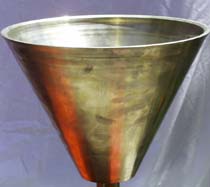 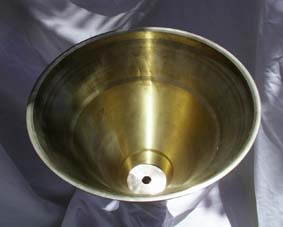
Harmonic bells can be tuned to the same pitch range as sets of tubular bells currently found in most symphony orchestras. They will be able to be used in repertoir that includes tubular bells with far greater certainty of pitch and consonance. The thin walled profile shown above is prefered in this context as it produces lower pitches at less wieght than thicker profiles suggested for carillons. Thinner profiles are also louder for the same energy of impact.
Australian Bell has produced a two chromatic octave set of harmonic bells for the Melbourne Symphony Orchestra. These sets of bells have not yet been seen or heard publically, but some were previewed in the premier performance of Ros Edward's Symphony No. 5 by the MSO at the Melbourne Town Hall in May 2000.
The largest bell is pitched at G3 and is over 1/2 a metre in diameter and weighs about 35kg. The 25 bells are arranged in 2 semi-circular frames that are a little over 2 metres each in diameter. The bell set contains bells of three distinct profiles. The higher the pitched bells have narrower profiles in order to reduce the circumference at the rim and so raise the pitch without reducing the size and loudness of the bells. The narrower profiles have fewer partials tuned harmonically (as few as 4) but this is not a concern acoustically as fewer partials have sustained resonances in high pitched bells.
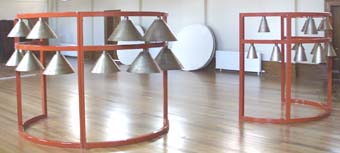 |
Orchestral bells in frames (low octave on left) |
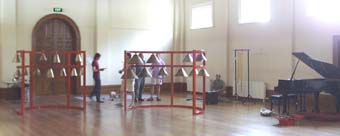 |
Testing the tuning of the orchestral bells and their sound in relation to the tubular bells and piano.
|
The orchestral bells were made by casting lugs that were cut to the required by profile on a computer controlled lathe. The bell was then fine tuned by hand on a vertical or horizontal laithes depending on size.
 |
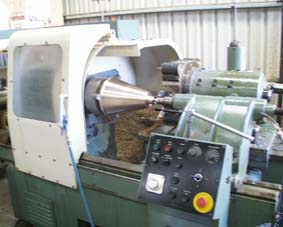 |
 |
Cast lugs |
Computer lathe at North Central Engineering |
Large orchestral bell being fine tuned on the vertical lathe |
HANDBELLS
Australian Bell has manufactured 2001 harmonic handbells as part of the celebrations of the Centenary of Federation of Australia. These bells are chromatically tuned over 2 octaves starting at E5. A special set of 1/4 tone bells has also been made for a piece for choir and bells by Constantine Koukias.

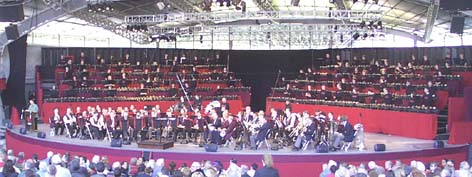 |
Performance of "Gates of Day" at the Sydney Myer Music Bowl, Melbourne Australia |
Australian Bell's handbells were used in the premier performance of Brenton Broadstock's composition "Gates of Day"commissioned by the Melbourne International Festival of the Arts in the celebratory year of the Centenary of Australia's Federation. The performance involved 400 players from communities in regional Victoria, 50 student percussionists, 3 of Victoria's premier brass bands and the Royal Australian Navy band. It was held at the Sydney Myer Music Bowl in Melbourne on the 3rd of November 2001.
Bell captain Graeme Leak and production manager Patrick Cronin rehearsed with community bell players from Portland, Bendigo and Knox who played individual bells in large groups as scored by Brenton, and in a short improvisation directed by Graeme. The community players surrounded the audience seated in the bowl creating a powerful, antiphonal bell chorus. The student percussionists from the Victorian College of the Arts and Collingwood TAFE played 2 octave chromatic sets of handbells in scored parts. These bells were arrayed around the back of the stage. A CD recording of the performance is available from the Australian Broadcasting Commission (ABC). See www.abc.com.au.
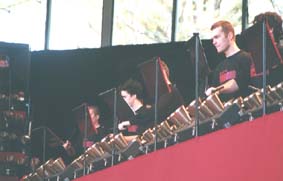 |
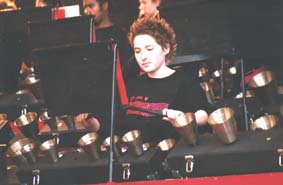 |
 |
Top: Student percussionists playing octave sets of handbells
Bottom: Community bell players
(all photos curtesy of Robyn McLachlan)
|
The following link will download (when we find time to finish it) a short exerpt of the handbell improvisation recorded by Australian Bell with help from RMIT University -  handbells 1 megabyte. It was recorded in three dimensions using a Soundfield microphone and has been post-processed as a binaural file using a Lake DSP processor. If you listen with headphones you may hear the recording in three dimensions (depending on how well your head and ear shapes match the binaural model!). handbells 1 megabyte. It was recorded in three dimensions using a Soundfield microphone and has been post-processed as a binaural file using a Lake DSP processor. If you listen with headphones you may hear the recording in three dimensions (depending on how well your head and ear shapes match the binaural model!).
The 2001 handbells will be permanently housed in Victoria's new museum in the Exhibition Gardens, Carlton. They will be available on loan to all Victorians for use in schools, community festivals and performances. Australian Bell is currently investigating the integration of the orchestral and handbell designs into a 3 and 1/2 octave set of bells, and the design of clappers for more traditional handbell performance modes.
The Melbourne Festival also commissioned a chamber work featuring the handbells, a male choir and three chanters by the Australian composer Constantine Koukias for the Federation Festival in May 2001. The piece entitled 'Pentakostarian-Prayer Bells for Federation' required three, two octave sets of 1/4 tone handbells tuned especially for this performance.
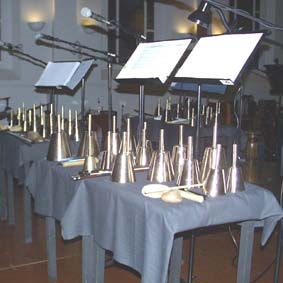 |
Quarter tone handbells on stage. Each member of the choir had a range of bells for their part. Bells were struck by a range of hammers and also bowed, scraped and clashed together for extended textural elements |
The handbells designed for these projects have been cast with a handle and do not have an internal clapper. This design made the project more financially viable and the bells more flexible in their musical applications. A major feature of this design is that the bells could be played in the manner of a xylophone or most other tuned percussion instruments. |

.jpg)

.jpg)